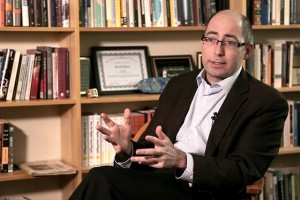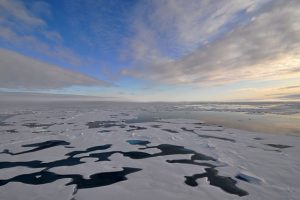American Physics in the Cold War
Physicist David Kaiser on the US education funding course, the impact of politics on physics, and connections ...
How is modelling approach used in climatology? What is confidence in climate models based on? What are the current models lacking? These and other questions are answered by Professor of Climate and Environmental Physics at Physics Institute of University of Bern Thomas Stocker.
So, one of the most powerful tools to estimate future climate change are climate models. Climate models are very powerful tools to understand the circulation in the atmosphere, the circulation in the ocean, the changes on the land surface, and are essentially mathematical, physical tools, because they are using equations of motion in the atmosphere that we are very familiar with, for example, from numerical weather prediction models that we are using day after day to predict the weather. Similar elements are in climate models that allow us to project future climate change.
However, to do that we also need to make assumptions about scenarios. Whenever people try to identify things that may happen in the future we think of scenarios – take, for example, your personal life. If you project yourself in twenty or fifty years you make a scenario. What if I earn a lot of money in twenty years? What if I lose my job in twenty years? This is a scenario, and climate models are using also scenarios regarding the emission of greenhouse gases. So we are looking at scenarios which describe a world that has made a transition away from fossil fuels to renewable energies, that is, the so-called climate mitigation scenario, in which a future climate change will be limited to less than 2 degrees, and other scenarios which we call ‘business as usual’ scenarios that continue with using fossil fuels.
Now this scenarios serve as input to the climate models and these climate models use a huge amount of computing time, and so there are now more than 20 centers worldwide who in a consorted effort are using these models, compare these models to one another, write scientific papers about understanding these models, comparing the models to the observations in the atmosphere, in the ocean, in the cryosphere – the frozen world. And so take confidence in the processes that these models describe.
Based on these simulations we can then look into the future – it’s like a window that opens itself up and tells us how climatic conditions in many regions of the world will look like in fifty years time, in a hundred years time depending on the scenario that we are inputting into these models.
Essentially these models tell us two different worlds. A world that shows a climate change that is limited, a world that will be different from the world as we know it today, will be warmer, the precipitation patterns will have changed, extreme events will have changed, sea level will have risen. But these are changes to which, we believe, that men can adapt. We can deal with these changes. This is fundamentally different from the results that climate models tell us for the ‘business as usual’ scenario in which the world will be by the end of the 21th century over 4 degrees warmer than during the end of the 20th century with consequent changes to the water cycle. Essentially, areas, that have abundant water already today and are facing flooding occasionally, will receive more water. And areas like the Mediterranean or other dry areas which are today challenged by the shortage of water will receive less water in the future. It is also a world where sea level will rise on the order of half a meter, perhaps, even up to a meter. A world that has completely different statistics of extreme events: heat waves will become much more frequent. Heavy precipitation events will also be frequent. And that means that serious challenges will lie ahead of us regarding adaptation. There will be many regions in the world where the limits of adaptation will be reached.
These climate models that inform us in a quantitative manner about at the consequences of our choices today.
We take a lot of confidence in these climate models. That confidence rests on two things that the scientists are actually very carefully looking at. The first thing is that we are using known physics, the physical processes that describe circulation, that describe the transfer of radiation from the Sun through the atmosphere to the Earth’s surface, and that we understand these physical laws that are basis of these climate models.
The second topic from which we derive confidence in two these climate models is their similarity with observed processes. So we can actually go back in time, fifty years, and look at observations, at modes of their ability, and ask these climate models whether they are able to reproduce what nature has shown us in terms of variations in the climate system. And these models on a large scale do a remarkable job in simulating the intricate behavior of the atmosphere and the ocean, the sea ice and other surface processes on the planet. And that is the confidence from which we build our projections. Obviously there are still remaining uncertainties. We have noted, for example, in the last assessment that was carried out by the intergovernmental panel on climate change that these climate models still have great difficulties in simulating the water cycle. And yet the water cycle is a fundamental resource for humans and ecosystems. So I am looking very much forward to a lot of progress in a climate model development in the near future regarding our ability to simulate water cycle changes.
So when we look at the way how scientists have modeled the climate system historically, then we look at an early phase, at the beginning of the 20th century, when the scientists tried to look into the past and extrapolate from time series by analyzing cycles, by looking at environment, try to forecast the future – this is a very empirical approach, which has no physical bases. But very early on, one of the pioneers was actually a Russian scientist Mikhail Budyko. He formulated one of the first climate models that was able quantitatively to inform us about the consequences of changes in the energy supply to the Earth and its implication on the temperature distribution as a function of the geographical attitude. That is where it started, the models were then built step by step. Certainly, the leading components were the atmosphere where people were familiar with the metrological processes that also play a crucial role for the climate change. These elements of the climate models are the most advanced ones. In the mid 70s then scientists coupled similar models for ocean circulation processes to these models. These are very important components, because they take up a lot of heat that is stored in the climate system and without an ocean component in these climate models you would not be able to faithfully project the climate evolution in the future.
The current development concerns the inclusion of chemical cycles, material cycles in these Earth system models. And the next steps will also be the inclusion of ice sheets into these climate models, because ice sheets are potential triggers of so-called ‘tipping points’ – instabilities that can unfold when the planet is warming. Ice sheets can become unstable and that would have a large impact on sea level and that is another quantity that these climate models are simulating.

Physicist David Kaiser on the US education funding course, the impact of politics on physics, and connections ...

Geographer Anson Mackay on threats to fresh water, the dangers of dead zones in the lakes and how people can a...

On climate formation, reconstruction methods, and the principle of actualism